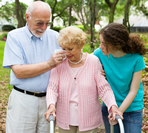Coping with Emotional Changes

Emotional or mood changes are common after a stroke. It is “normal” for stroke survivors to have many different feelings. Some people are sad because they have trouble walking or talking. Other people seem cheerful and happy because they survived.
What are Common Emotional Changes After Stroke?
Keep in mind that not all stroke survivors have the same feelings. Below are common changes that may occur. You are the key to recognizing emotional changes that are problems. Get help quickly.
Changes in feelings:
- Feeling worthless
- Depression or sadness
- Lack of motivation or drive
- Being overly sensitive
- Anxiety or worry
- Frustration
Changes in behaviors:
- Angry outbursts
- Crying or laughing at the wrong things
- Losing one’s temper
- Trouble caring for self or others
What Do You Need to Know?
Emotional changes in your loved one are real. Expect that things will get better.
Most emotions are normal after a stroke, but watch for these two Red Flags:
|
Red Flag: Suicide and Stroke 
If the stroke survivor talks about suicide, has thoughts of suicide, or attempts suicide, get help right away. Call emergency services or your healthcare provider. This is a serious problem. |
|
Red Flag: Rapid Mood or Emotional Changes 
Rapid mood changes are crying out of control one minute and then quickly laughing without reason. |
What Treatments Should You Discuss with Your Healthcare Team?
The stroke survivor and family members may explain away the person’s moods. You, as the caregiver, must make sure that your loved one gets treatment. There are many good treatments for emotional changes. These treatments may speed up your loved one’s recovery.
- Medicines, such as anti-depressants, improve symptoms and reduce rapid mood changes.
- Psychotherapy (talk therapy) is used along with medicines. Talk therapy gives your loved one a safe place to talk about feelings.
- Support groups provide help from other stroke survivors and caregivers. They know what you and your loved one are going through. There are support groups for stroke survivors and caregivers like you. Learn more about stroke support groups.
Helpful Tips
- Encourage your loved one to exercise and take part in fun activities.
- Be patient with your loved one. It will take time to adjust to the changes
- Allow time to talk about negative and positive feelings.
- Encourage family and friends to visit.
- Focus on what your loved can do. Smile and relax about things you can’t change.
Remember
- Watch for signs and symptoms of difficult emotional changes. Talk with your healthcare team right away.
- Exercise and do fun activities with your loved one.
- Be patient. Laugh and talk with your loved one.
Other Resources 
Additional credible resources on this topic can be found here. Website pages may change or update, therefore if a link does not work, you may also try to type the information into your internet search bar. This Resource List will be updated frequently.
References: American Stroke Association. (2008). Retrieved July 11, 2008, from: http://www.americanheart.org/presenter.jhtml?identifier=3047697*; Family Caregiver Alliance. (2008). Retrieved July 11, 2008, from: http://www.caregiver.org/caregiver/jsp/publications.jsp?nodeid=345*
These materials were created for the project:
Web-Based Informational Materials for Caregivers of Veterans Post-Stroke
Project Number SDP 06-327 funded by VA HSR&D Quality Enhancement Research Initiative (QUERI)



















